Restaurant Critic Mean-Spirited, Entertaining
“Mr. White has said he engineered the dough to stand up to the rigors of delivery and reheating with no loss of quality. In that, at least, he has succeeded. Warmed up a day or two later, a Nicoletta crust is just as stiff and bland as when it was fresh from the oven.”
— Pete Wells gets out his razor blades in his review of Michael White’s new East Village pizzeria, Nicoletta. The seafood atop the insalata mista is “as tender as an extension cord,” he says.
The Impenetrable Semiotics Of Laundry
The Impenetrable Semiotics Of Laundry
“28 years old and still no idea what the little laundry instruction symbols mean.” I think the second-from-left on the top row indicates that the garment should not be handled by a member of the Illuminati, but other than that I am equally stumped.
Tonight You Are Going Out For Sure
You know we love some Mary Halvorson, and her new quartet is playing tonight at Barbes; but also! Bettye Lavette in Madison Square Park and M83 in Central Park??? Plus Awl pal Jenna Wortham and boys answer questions at Housing Works.
Robert Hughes, 1938-2012
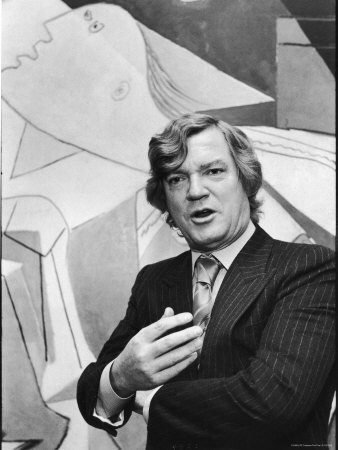
The Australian art critic and historian Robert Studley Forrest Hughes died yesterday at the age of just 74. He’d withstood such a lot, coming back after weeks in a coma following a terrible car accident in Australia in 1999. I thought he was so strong that he would still live to be 100. Part of his name, even, was ‘Studley’! And that is just what he was.
What is the best thing Hughes ever did? How to choose from this embarrassment of riches? The obvious answer would be his stately, gorgeously comprehensive history of the convict settlement of Australia, The Fatal Shore (1987). Equally obvious: the 1980 TV series “The Shock of the New,” which you can watch in its entirety online. This is the thing that brought him fame, and no wonder. It’s a marvel: a solid education in post-Impressionist modern art of the 20th century in the form of a luscious entertainment stretching over hours and hours; awareness, scholarship, wit, and a visual sensitivity matched for once by an equally sensitive sense of language, all delivered in a brisk, whip-smart, slightly clipped Anglo-Australian voice of enormous power and beauty.
But there was so much, much more.
There’s his art criticism in prose, as collected in part in Nothing If Not Critical; his sumptuously pleasurable book about Barcelona. There’s his fire-breathing political writing, notably the book The Culture of Complaint, an indispensable salvo fired in the culture wars. Hughes’s troubling and beautiful memoir, Things I Didn’t Know, would alone have been enough to secure his fame, and yet it’s one of his lesser works; it was reviewed by fellow Australian Clive James in one of the most beautiful reminiscences of one friend for another in modern letters. James and Hughes were at university together, and his memories have that indefinable intimacy possible only between those with a shared youth.
Among my generation of aesthetes, bohemians, proto-dropouts and incipient eternal students at Sydney University in the late 1950s, Robert Hughes was the golden boy. Still drawing and painting in those days, he wrote mainly as a sideline, but his sideline ran rings around his contemporaries, and his good looks and coruscating enthusiasm seemed heaven-sent, as if the mischievous gods had parked a love-child on us just so they could watch the storm of envy.
No lie, he was good-looking too, brilliant, accomplished. From a patrician Catholic family. But what really got James into a companionable tizz was Hughes’ success as a lover.
He admits that he had a good memory, for example, but should have said that it was photographic. He admits that he was active as an illustrator for the student magazines and stage productions but should have said that his speed and skill left us flabbergasted. He admits that he flourished as a student journalist but fails to add that the downtown editors stormed the university walls and kidnapped him. He admits that he did all right with the girls but forgets to say — ah, this is the unforgivable malfeasance — that he cut a swathe without even trying.
Brenda, a British ballerina from the touring Royal Ballet, at least gets a mention. I remember her: she was so graceful that you went on seeing her with your eyes closed. The gorgeous Australian actress and future television star Noeline Brown gets a longer mention, as well she might: I knew Hughes well enough to see him in her company many times, and there wasn’t an occasion when I didn’t whimper from envy. But there was another one, called Barbara, who looked as if she spent her spare time standing in a sea-shell for Botticelli, and she doesn’t even get a sentence.
But let’s not forget to have the rough with the smooth. Hughes wasn’t the least bit nice. Oh no. He was downright vicious, mean as a snake, and hilarious. So mean that you would feel guilty from laughing. The drubbing he gave Julian Schnabel for daring to write a memoir! “The unlived life is not worth examining.” And Jeff Koons! “Koons is the baby to Andy Warhol’s Rosemary. He has done for narcissism what Michael Milken did for the junk bond.”
My favorite of Hughes’s many hatchet jobs is “The Patron Saint of Neo-Pop” [paywall], a positively lethal NYRB poison-pen essay he wrote about Jean Baudrillard, the French writer who’d arrived at the intersection of fashionable art criticism and poststructuralism in the 1980s. Oh man. The poor wretch didn’t stand a chance.
Jargon, native or imported, is always with us; and in America, both academe and the art world prefer the French kind, an impenetrable prophylactic against understanding. We are now surfeited with mini-Lacans and mock-Foucaults. To write straightforward prose, lucid and open to comprehension, using common language, is to lose face. You do not make your mark unless you add something to the lake of jargon whose waters (bottled for export to the States) well up between Nanterre and the Sorbonne and to whose marshy verge the bleating flocks of poststructuralists go each night to drink.
At a time when a lot of ink is being spilled about the excess of “niceness” infesting cultural discourse, criticism and journalism, Hughes’s entire and total not-niceness comes as a bracing restorative. Though he really took it way way too far, sometimes, for the most part the formidable scholar in Hughes — meticulous, exact, unflinching — tempered his anger into a searing brilliance. And as mighty as his instrument could be — I thought of him as a Hephaestean writer, in a lot of ways — he could also wield it with all the Apollonian delicacy in the world.
Claud Cockburn, in one of his volumes of autobiography, recounts how as a reporter in the thirties he had gone to interview a big American hot-gospeler who had crossed the Atlantic to convert England. Cockburn pressed this mild and hearty soul for a description of God. What was his ideated form of the deity? The evangelist allowed that he never imagined God as an old man with a beard in the sky. “My conception of Him,” he told the rporter, “is something like a great, oblong, luminous blur.”
That was all Rothko had, by way of religious imagery. In anguish, the blur was dark; in respose and happiness, suffused with the peachiest and most delicately tuned colors. In their similarity to landscape, the august blurs stacked up the canvas often connect Rothko’s work to an older American tradition, that of Luminist painters such a s Kensett and Heade: horizon, mountain and light seen as God’s handiwork, the Great Church of Nature. […] One does not read Rothko’s tiers and veils of paint primarily as form: they are vehicles for color sensation, exquisitely set forth in a technique that descends from Rothko’s watercolors of the 1940s — wash upon wash of thinned pigment soaked into the surface, filtering the light.
Such a blow, that he is gone. Adieu, Maître.
Maria Bustillos is the author of Dorkismo and Act Like a Gentleman, Think Like a Woman.
New York City, August 6, 2012
★★★★ Busily agreeable. Clear, powerful sunlight caught on the edges of the clouds, making them glow stark white, and was content with that as a show of strength. No reason to cause suffering at ground level. People rode nonperformance bicycles along the streets of Chinatown, at a stately pace. Breezes were fresh and mild, moving in pleasantly unexpected eddies: warm air in the cool spots and cool in the warm spots. A laundromat’s exhaust and the vapors of glistening new asphalt got stirred up and bustled along, inoffensive and fleeting.
Violence and Making Sense
by Jay Caspian Kang
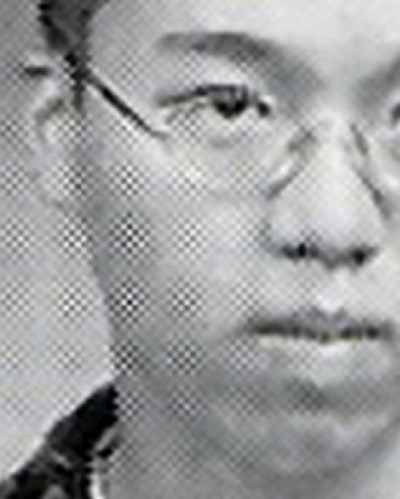
Three years ago, I set out to write a novel about Cho Seung-Hui, the shooter in the Virginia Tech massacre. Since Columbine, I have held an unhealthy interest in the way the media, and by extension, the greater moralizing population, processes mass killings. Cho was a Korean-American from the South who had entered college with dreams, however mangled and bizarre, of becoming a writer. That same sentence could have been written about me. As the evidence of Cho’s derangement began to surface in the videos, short stories and plays he left behind, it became clear that Cho had been trying to tell a righteous story, where the “rich kids” and “brats” were cleansed from the earth by a sort of Frankenstein’s monster of messianic figures and revenge-movie heroes. The story, of course, makes no sense, but the similarities between Cho and my younger self, who also had fits of anger at those same collegiate rich kids, who spent time in counseling as an adolescent for drawing disturbing pictures in class, presented a discomforting question. What, really, was the difference between us?
It has been a particularly fruitless obsession. Every time a report of a mass killing flickers through my Twitter feed, RSS reader or any of the dozen or so ways in which I receive the news, I go straight to the television and watch CNN or Fox News or whatever else without an educated opinion about anything. I have no opinions on gun control that go beyond what the shouting heads might say. My thoughts on what societal factors might trigger these killing sprees rarely stray far from a morose, “Good Lord, how have we come to this?” This past April, I headed up to Oakland after another Korean-American named One L. Goh executed seven of his former classmates at Oikos University, a small nursing school with ties to a local Korean-American church. After conducting a month of interviews and spending days parked out in front of the school, I came no closer to any sort of actionable idea.
There is simply no allegorical, edifying or fully-formed way to show completely senseless acts of violence. The narrative always skids right up to the point where the young man, who was so much like other young men, begins assembling a small armory. After the jump, a story that had been told in the fraudulent math that tries to balance a recognizable, human childhood with an incomprehensible, inhuman act, switches over to the fractured language of the newscast: helicopter images, computer re-enactments, grainy home videos, 911 calls, yearbook photos, the shots of children who could be our children crying in small huddles outside the crime scene. After two years of reading, watching and listening to pretty much everything about Cho Seung-Hui, I realized, with a thin flare of defeat, that the distance between us could never be measured, at least not in any instructive way.
The Dead Do Not Improve was written out of this bewilderment. Only through fiction’s slower, yet more chaotic logic could I find a way to talk about Cho Seung-Hui. The novel is not a polemic or even political. But if fiction is the way some neurotic or over-caffeinated people unravel, shape and animate questions that ultimately have no good answer, the book is my entry into the parade of misshapen golems. Again, there are no answers in the novel about mass killings or Cho in the novel. (I don’t even really know what a novel of determinations, explanations and answers about senseless mass killings would contain. Who would be the protagonist? What would the cover look like?) Cho Seung-Hui, James Holmes, Dylan Klebold, Eric Harris and the dozens of other men who, over the past two decades, walked into very public spaces with guns, inspire terror because of everything we don’t know. When your particular churn logic cannot limit you and your demographic out of the potential targets, you start wondering what, exactly, has come of this country.
The story of Wade Michael Page, the man who apparently killed seven people and wounded three more at a Sikh temple in Oak Creek, Wisconsin, does not screech to a halt when a forty-year-old white supremacist starts stockpiling weapons. We can do the math behind Page’s killing spree through the same pathways with which the greater American public — however bull-headedly — processes terrorists. A man gets caught up in an ideology of hate. He decides to act on this ideology in the most horrific way possible. Point A leads directly into Point B and although Point B is horrific, it is something we have grown to understand. Who, when first hearing of the news, didn’t assume the killings were an act of racial hatred? Who didn’t start to piece together the turbans, the brown skin, the epidemic of post-9/11 violence that is under-reported, or at least never has all its incidents connected? Because the logic of Oak Creek can be traced to an endpoint (even if the logic is wrong) and because that endpoint only implicates a small percentage of Americans, the story of the massacre at Oak Creek will be, by definition, exclusionary. It will be “tragic” and “unthinkable” and “horrific,” but it will not force millions of Americans to ask potentially unanswerable questions. It will not animate an angry public. Chick-fil-A will outlast Oak Creek as a source of indignation.
But for those who cannot limit themselves out of the victims of Oak Creek, logic follows a brutal path. Many of the Sikh leaders interviewed over the past two days have intimated that they had been dreading this day for years. For them and many Brown people in the United States, the years since 9/11 have been filled with violent incidents that are all too explainable. I do not mean to say that we should compare and conflate Aurora and Oak Creek. Quite the opposite. We should remember that Aurora was the latest in an American epidemic of mass, easily produced violence, while Oak Creek was the product, although certainly not the end-product, of what happens when a society turns a colorblind eye towards years of violence against Brown people in the name of 9/11 and the War on Terror.
This is not the time to throw up our hands and hide behind the silencing curtain of race-blindness. Nor is it the time to repeat the polite, leveling logic that says that all American tragedies are alike. It is certainly not the time for literary bewilderment. At a time when political leaders, including the two men who aim to lead this country for the next four years, have said nothing but the politest condolences for the dead, Aurora and Oak Creek should both be at the forefront of our national discussion. One should never stand in for the other.
Jay Caspian Kang writes for Grantland and contributes to The New York Times Magazine. He’s also the author of The Dead Do Not Improve, released today.
Unrealistically Depicted Human All Too Human

“Kathy Zeitoun said she considers Eggers’ book a faithful and accurate portrait of the couple’s shared ordeal during Katrina. But she believes she must publicly shed light on her ex-husband’s violent side, which she says has emerged in recent years. ‘I’m not going to be quiet about it anymore because being quiet puts him in a position to do it again,’ she said.”
— Well, this is very sad. Abdulrahman Zeitoun, the protagonist of Dave Eggers’ account of Hurricane Katrina and the atrocious government response that followed, is in jail for assaulting his wife. Zeitoun is beautifully written, and gives an invaluable look at a city in the wake of natural disaster, but it bothered me very much in its depiction of its eponymous hero as a flawless human being. [via]
If the Olympics Has Taught Us Anything, It's...
Straight men don’t really know anything about penises, because they never see any. Except apparently for Gawker’s John Cook, who really knows from cock.
Seven Awesome Campgrounds To Head To On A Roadtrip
Seven Awesome Campgrounds To Head To On A Roadtrip
by Megan L. Wood
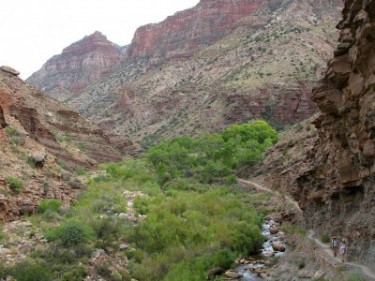
This post is brought to you by NEW Armor All Extreme Shield Wax. Help keep your car looking as good as the day you bought it with Armor All. Go to Facebook.com/ArmorAll for a $10 rebate.
Recently, I had the following conversation with my boyfriend:
Me: “I love to camp! Let’s quit your job and go camping for an entire year at different campgrounds across the United States. We can write a book about it!”
Him: “We don’t have any camping gear.”
Me: “Yes, we do. We have camping dishes and a dog.”
Him: “We can call the book, How We Accidentally Killed Our Beagle: A Year Of Camping.”
Okay, so neither my boyfriend (or my dog) are interested in excessive camping. But I am. Growing up, my family went on about one vacation every year. When money was tight, my parents would attach the pop-up camper to the back of our van and drive all five of us to a campground. Though I loved cooking over a fire, sleeping bags, and endless games of Connect Four — plus pretending to be Laura Ingalls Wilder — looking back I can see my parents picked some pretty generic campsites. Mostly, they were just black patches of dirt with enough space to park the car next to a circle of stones and a picnic table. After riding my bike all afternoon, it was difficult to tell exactly which of the 100 or so identical campsites belonged to my family. Campground amenities included a ranger’s station and a murky lake, maybe some hiking trails. There are some uninspired campgrounds out there.
But the good old U.S. of A. is also home to campgrounds with plenty of personality. There are tens of thousands of campsites in the United States, and the National Park Service is ramping things up to get ready for their centennial in 2016. A campground doesn’t have to be a National Park to be awesome, though clearly federal funding can’t hurt.
Here are seven of the country’s awesome campgrounds. BYO dog. It adds to the awesomeness.
Admit That You Watch “Swamp People”: Okefenokee National Wildlife Refuge, Georgia and Florida
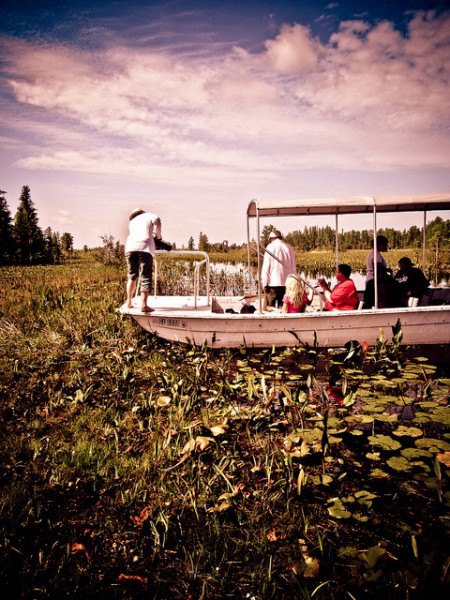
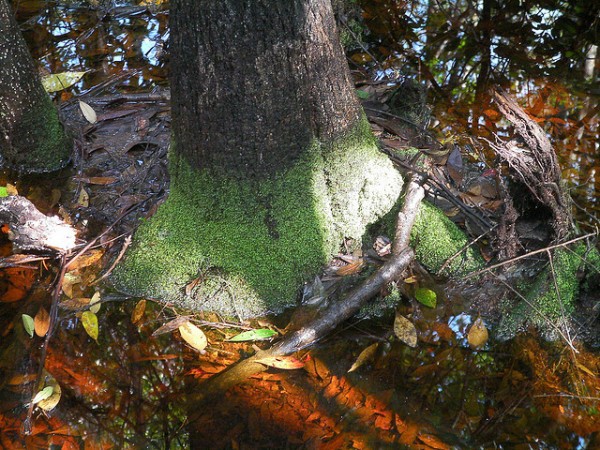
If Okefenokee were a movie, it would be an action film. The refuge’s recent history has included a couple massive wildfires; and the peat-filled wetland, named “Land of The Trembling Earth by the Choctaw Indians, is inherently unstable — trees and bushes actually shake from the shifting of the earth. The swamp is home to a massive array of wildlife: alligators, carnivorous plants, 64 species of reptiles, and bears. Campers can set up their tents on one of seven wooden platforms built directly over the swamp. If you really want to get in the spirit of living like a swamper, canoe over to the abandoned Chesser Homestead, where a family of settlers lived in the late 1800s. For an estimate of how many alligators you might see, check out this alligator forecast.

Get there: Several campsites are reachable by car. Bonus points if you can strap a canoe or kayak to the car’s roof. (More info.)
Stop it, Pervert: Big Bone Lick State Park, Kentucky
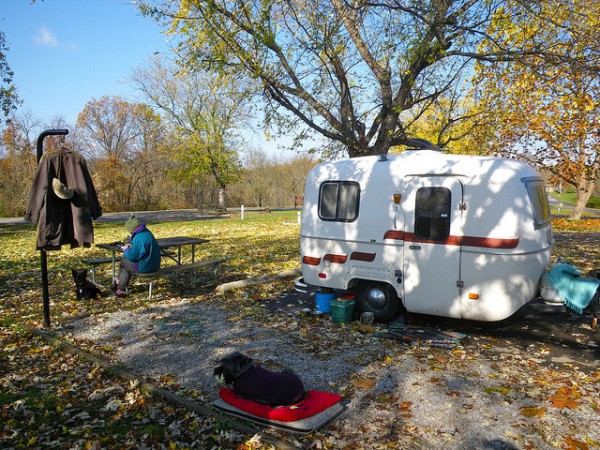
This campground is named, not for porn stars, but for the fossils found here. Around the time of the last Ice Age, enormous mammoths and mastodons lived, grazed, and licked salty mud to supplement their diets. Because the land was a marsh, some of the animals got stuck and died. In the 1700s, Europeans found fossils and (big) bones. Thomas Jefferson sent Meriwether Lewis (you know, from Lewis and Clark) to bring some of these finds back to the White House. Today, scientists recognize Big Bone Lick as the “Birthplace of American Vertebrae Paleontology.” Campers can view fossils, teeth, and bones at the Outdoor Museum. Or skip that, and gawk at the herds of living buffalo near the sulfur springs.
Get there: Drive through Beaverlick. Yes, really. (More info.)
Everyone Knows It, But Still Worth It: Grand Canyon National Park, North Rim Campgrounds, Arizona
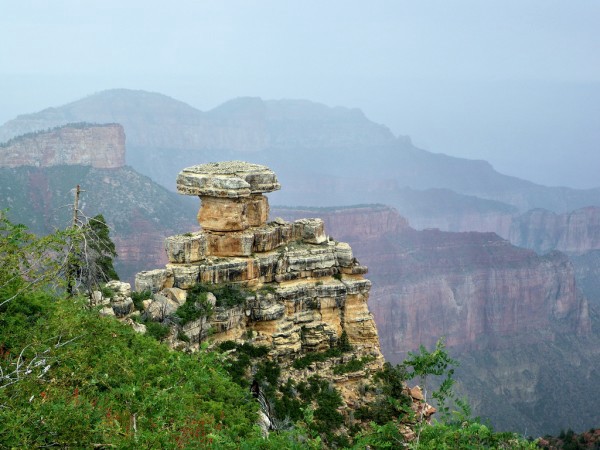
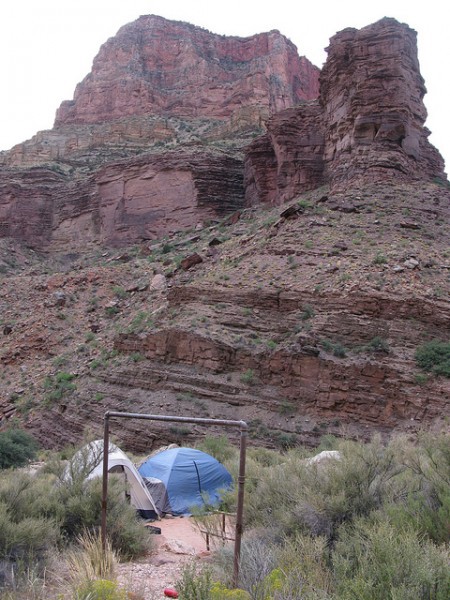
Inside the Grand Canyon National Park, campsites are available on the North and South rims of the canyon. The North Rim is further than the South Rim, but what you have from the North Rim is an unaltered view of the nation’s most superlative canyon. Some of the tents sites are as near as 20 feet from the edge — these probably wouldn’t be great for toddlers or sleepwalkers. Everyone else should book five months in advance for the sites with the best views. Of course, if you’re really hardcore, apply for a permit to spend the night below the rim. But wherever you camp, you’ll want that permit: heed this cautionary tale!
Get there: Vehicle access is allowed into the campsite or hike 1.5 miles carrying all your gear on your back. (More info.)
Stepping Back Into The 60s: Mystic Hot Springs, Utah
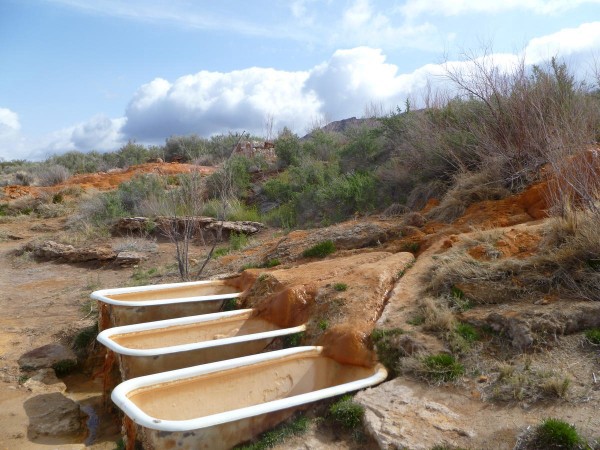
Particulars, like reservations, aren’t really the vibe at Mystic Hot Springs campground. Wonderfully, the website states that, while the bathtubs are cleaned every morning, the pools are cleaned “once or twice a week.” It’s honesty and flexibility like that which make Mystic Hot Springs an awesome campground. And of course, the natural springs of water that come out of the ground at 168 degrees Fahrenheit, for soaking in eight bathtubs built into rocks and two concrete pools. Oh, and you shouldn’t drink the calcium, magnesium, and iron rich water. Oh, okay, but only drink 1 oz per day, at the most.
Get there: Mystic Mike, the current owner of Mystic Hot Springs, first stumbled across the spot via a bus while driving to Denver from a Dead Head concert in Vegas. I suggest you do the same. (More info.)
Ancient States: Gallo Campground, Chaco Culture National Historic Site, New Mexico
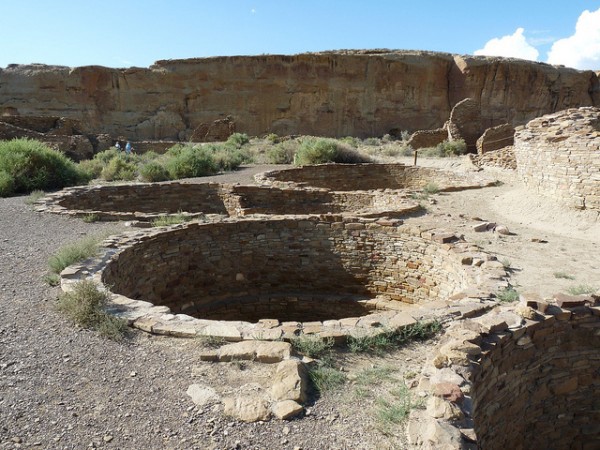
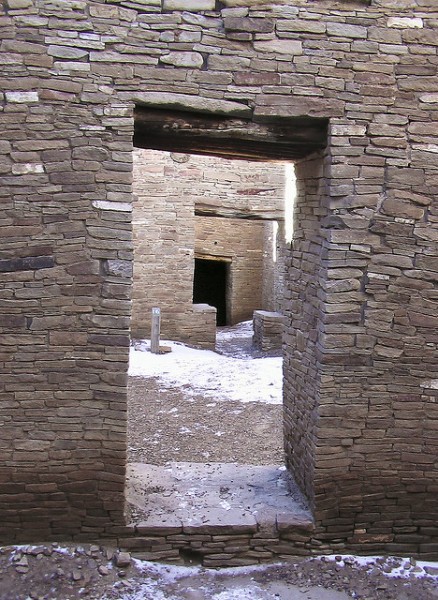
Gallo campground is rugged. There is no shade in the desert. But there are petroglyphs, dramatic ruins, and unexcavated dwellings. There used to be a thriving culture here, with commerce, irrigation, sophisticated communications, and buildings constructed around solar and cardinal directions. Now, there are the remains of a once great civilization — and campgrounds. The massive buildings of ancient Pueblo people are still standing, left from 850 A.D, including Pueblo Bonito, which once had around 800 rooms and was several stories high. I’m not telling anyone to do anything disrespectful or illegal, especially because the Chaco is still used by native decendants as a sacred and religious place, but a little peyote would probably go a long way “at the center of an ancient world.”
Get there: Drive 13 miles down a rough dirt road in a car packed with food, firewood, and water. Supplies aren’t available inside the site. (More info.)
Your Name Is Mudd: Garden Key Campground, Dry Tortugas National Park, Florida
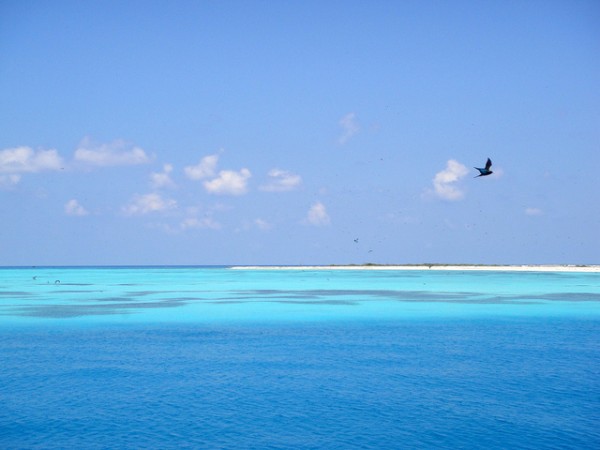
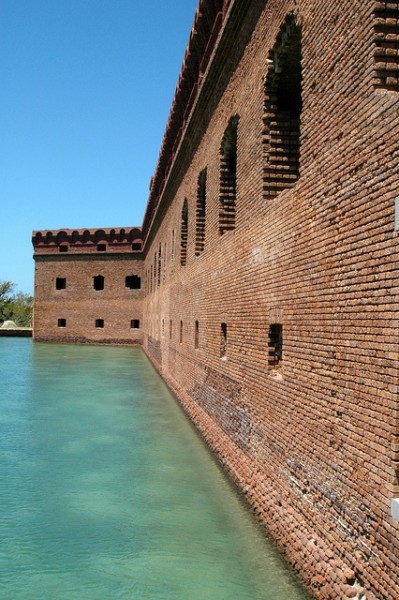
“Camping” on the beach is what alcoholics in Venice, California say they’re doing when they pass out on the sand. And that’s illegal. But sleeping on the beach at Dry Tortugas (the nation’s only at-sea national park) is not only legal and encouraged, but it only costs three American dollars each night. Even if you pass out from too many adult camping beverages, you’ll still be able to wake up and stumble into the ocean to snorkel in the Great Barrier Reef. Serious divers have quick access to shipwrecks, shoals, and coral. History lovers, and those who love spooky ghosts will be interested in exploring nearby Fort Jefferson, which was built during the Civil War, and was once home to thousands of soldiers and prisoners, including Dr. Samuel Mudd, the traitor who helped John Wilkes Booth after he assassinated President Lincoln.
Get there: To get to the park from Key West you can take a sea plane or a boat shuttle. Look for dolphins! And turtles! (More info.)
You Fancy, Huh?: The Resort At Paws Up, Greenough, Montana
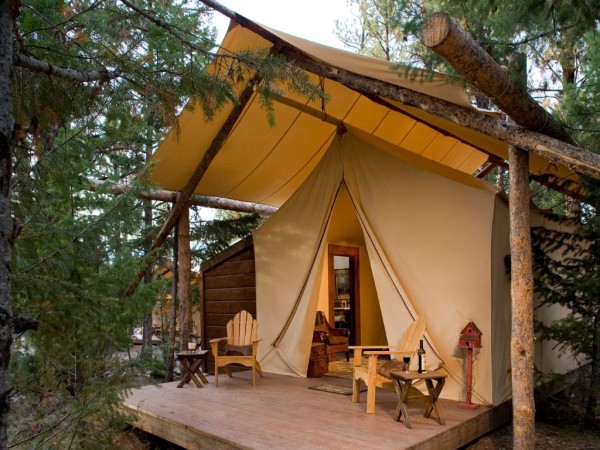
Montana + Spa + Camping = Glamping on a ranch. If you ever watched “Hey Dude” then you’re familiar with Mr. Ernst and ranches. You’re also familiar with that spoiled rich-girl brat Brad. Paws Up would be the kind of place she’d vacation with her family. Remember the episode where her dad bought her a convertible? Anyway, if you want to fall asleep amidst the sounds and smells of nature, but you also want to enjoy perks of massage, housekeeping, gourmet meals, and a butler, then you probably want to go glamping. Or, take your 1% lifestyle one step further and choose the option of renting a cabin (mansion) with a tent in the yard. Then take your friends out there with a bottle of Clos Du Mensil 1995 and say things like, “Oh, Brad! Remember that summer you worked on the ranch with Mr. Ernst? Why would anyone sleep in a tent, when there are mansions?” Then go back inside and do whatever it is that wealthy people do at night. Check your portfolio or something.
Get there: Land your private plane at Missoula International Airport. Look for a driver holding a placard with your last name near baggage claim. Get in the back of the car and complain about baggage restrictions on commercials flights. Or, drive yourself. (More info.)
With This Ring, I Thee Wed: Devil’s Lake State Park, Wisconsin
Technically, this is number 8, but it should be included because my brother recently proposed to his girlfriend here. On a hike. During sunset. So. Take your kids camping and maybe they’ll grow up awesome and attract wonderful mates. And yes, the happy couple has a dog. Maybe they’ll honeymoon at Mystic Springs.
Get there: Be willing to totally open your heart and mind to another person with similar values. Or, drive.
Roadtrip related: Best Audiobooks and Best Gear
Sponsored posts are purely editorial content that we are pleased to have presented by a participating sponsor, advertisers do not produce the content.
Megan L. Wood uses her middle initial to distinguish herself from all the other women named Megan Wood. Top photo of Grand Canyon courtesy of Grand Canyon NPS; photos of Okefenokee Swamp by Moultrie Creek Jo Jakeman U.S. Fish and Wildlife Service Southeast Region; Big Bone Lick photo by PunkToad; photos of Chaco Culture National Historic Site by Jason Hickey and Angel Schatz; photo of Grand Canyon North Rim by AIHikes_AZ and Grand Canyon NPS; photos of Dry Tortugas National Park by Matt Kieffer and viadeb.
Dog-Riding Monkey Thinks He's Texas People
Is this Texas’ tiniest rodeo cowboy? Sure, why the hell not. Also worth noting: “He’s no prima donna.”
